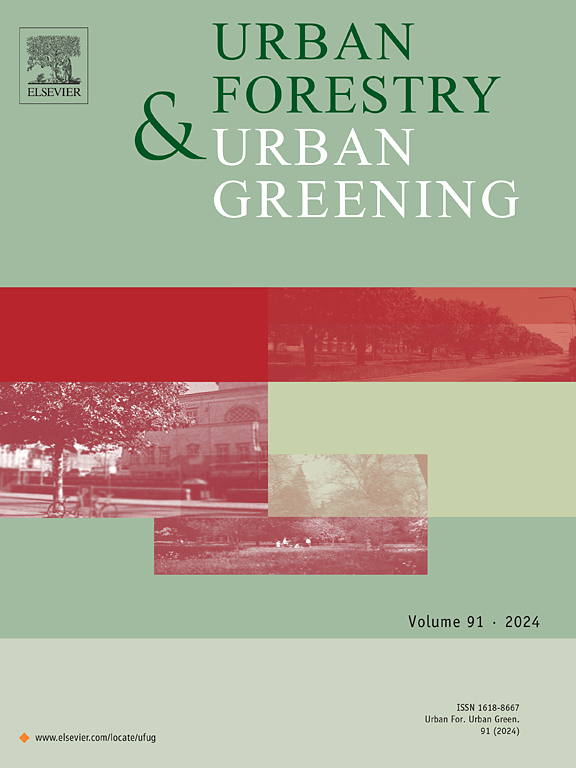检测行道树和绿地:了解城市树木对减缓气候变化的贡献
IF 6
2区 环境科学与生态学
Q1 ENVIRONMENTAL STUDIES
引用次数: 0
摘要
城市树木对适应气候变化非常重要;然而,由于缺乏描述城市树冠覆盖和碳储量分布的精细数据,人们无法认识到城市系统对减缓气候变化的贡献。在此,我们介绍了一种通过使用空间分辨率为 0.298 米的谷歌地球图像,将分段任何模型和植被指数结合起来,提取精细树冠覆盖的方法。我们利用多源遥感数据和机器学习技术估算了武汉市树木覆盖区域的地上生物量,该地区是中国城市化的代表。结果表明,树冠覆盖面积占研究区域的 18.86%,这意味着全国范围内城市树木的比例可能占森林总面积的 1.88-2.69%。由于人为管理水平较高,城市地区的树木生长保持相当稳定,武汉市树木覆盖区域的地上生物量碳密度为 60-86 兆克碳/公顷。与基础设施保持一定距离的行道树代表了地面生物量的平均水平,而相对较远位置的城市树木则是地面生物量的主要贡献者。我们的研究强调了城市树木的碳储量以及间接影响碳排放的各种机制,是一种潜在的基于自然的解决方案。我们建议加强城市系统的社会生态特征,以应对未来的气候变化。本文章由计算机程序翻译,如有差异,请以英文原文为准。
A detection of street trees and green space: Understanding contribution of urban trees to climate change mitigation
Urban trees are important for adapting to climate change; however, the absence of fine-grained data describing the distribution of urban tree crown cover and carbon stocks hinders recognition of the contribution of urban systems to climate change mitigation. Here, we present an approach for extracting fine-grained tree crown cover by coupling the Segment Anything Model and vegetation indices using Google Earth imagery with a spatial resolution of 0.298 m. We estimated the aboveground biomass of tree-covered regions in Wuhan, representative of China's urbanization, using multi-source remote sensing data and machine-learning techniques. We show that tree crown cover accounts for 18.86 % of the study area, implying that the nationwide proportion of urban trees probably represents 1.88–2.69 % of the total forested area. Tree growth in urban regions remains reasonably stable owing to the high level of human management, with a 60–86 Mg C ha−1 carbon density of aboveground biomass in the tree-covered region in Wuhan. Street trees at specific distances from infrastructure represented an average level of aboveground biomass, whereas urban trees at relatively distant locations were the dominant contributors to aboveground biomass. Our study highlights the carbon stocks of urban trees and the various mechanisms that indirectly influence carbon emissions, representing a potentially promising nature-based solution. We recommend enhancing the socio-ecological characteristics of urban systems to address future climate change.
求助全文
通过发布文献求助,成功后即可免费获取论文全文。
去求助
来源期刊

Urban Forestry & Urban Greening
FORESTRY-
CiteScore
11.70
自引率
12.50%
发文量
289
审稿时长
70 days
期刊介绍:
Urban Forestry and Urban Greening is a refereed, international journal aimed at presenting high-quality research with urban and peri-urban woody and non-woody vegetation and its use, planning, design, establishment and management as its main topics. Urban Forestry and Urban Greening concentrates on all tree-dominated (as joint together in the urban forest) as well as other green resources in and around urban areas, such as woodlands, public and private urban parks and gardens, urban nature areas, street tree and square plantations, botanical gardens and cemeteries.
The journal welcomes basic and applied research papers, as well as review papers and short communications. Contributions should focus on one or more of the following aspects:
-Form and functions of urban forests and other vegetation, including aspects of urban ecology.
-Policy-making, planning and design related to urban forests and other vegetation.
-Selection and establishment of tree resources and other vegetation for urban environments.
-Management of urban forests and other vegetation.
Original contributions of a high academic standard are invited from a wide range of disciplines and fields, including forestry, biology, horticulture, arboriculture, landscape ecology, pathology, soil science, hydrology, landscape architecture, landscape planning, urban planning and design, economics, sociology, environmental psychology, public health, and education.
 求助内容:
求助内容: 应助结果提醒方式:
应助结果提醒方式:


